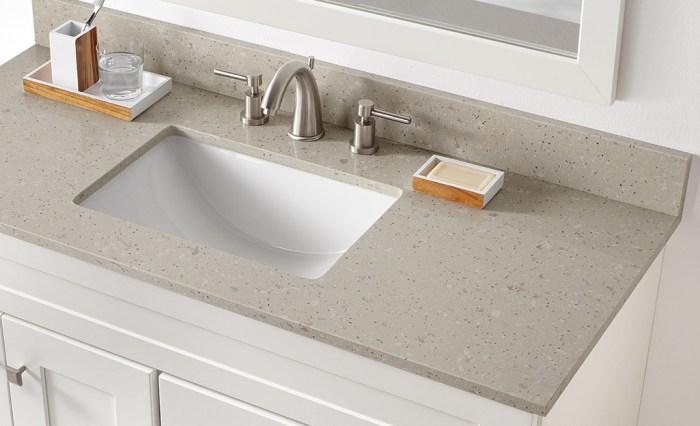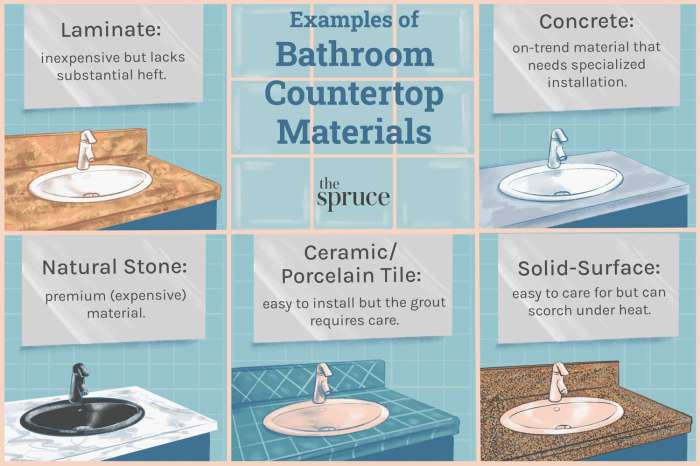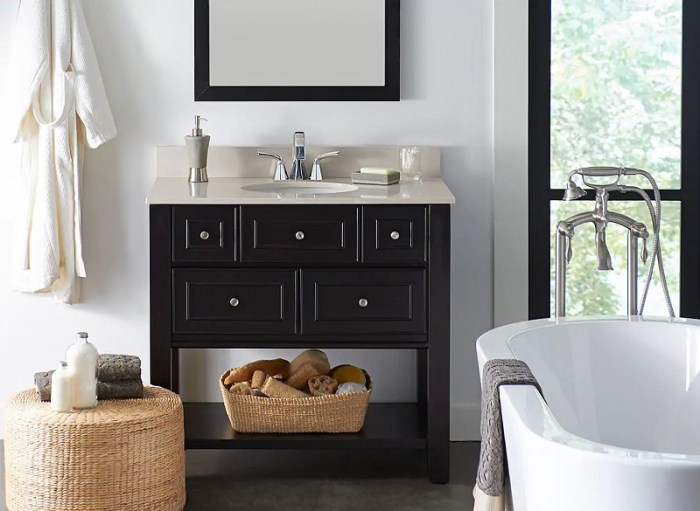The bathroom vanity top is a crucial element that sets the tone for the entire space. With a wide array of materials available, choosing the right one can be a daunting task. This comprehensive guide will provide an in-depth comparison of the most popular bathroom vanity top materials, helping you make an informed decision based on durability, style, and sustainability.
From the timeless elegance of natural stone to the modern appeal of engineered materials, we will explore the pros and cons of each option. Whether you prioritize durability, stain resistance, or aesthetics, this guide will empower you to select the perfect vanity top that complements your bathroom design and meets your functional needs.
Material Options
When selecting a bathroom vanity top material, there are several options to consider, each with its own unique characteristics and benefits. The most common materials include granite, marble, quartz, and laminate.
Material Comparison
The following table compares the key characteristics of these materials to help you make an informed decision:| Material | Durability | Stain Resistance | Cost ||—|—|—|—|| Granite | High | High | Moderate || Marble | Moderate | Low | High || Quartz | High | High | High || Laminate | Low | Low | Low |
Durability
The durability of bathroom vanity tops is a crucial factor to consider, as they endure daily use and exposure to various elements. Several factors influence the longevity of these surfaces, including the material’s composition, construction, and maintenance practices.
Different materials exhibit varying levels of durability under different conditions. Some are highly resistant to water, heat, and impact, while others may be more susceptible to damage.
Water Exposure
Water resistance is essential in bathroom environments. Constant exposure to moisture can lead to warping, swelling, or discoloration in certain materials. Solid surface materials like quartz and acrylic are highly water-resistant, making them ideal for areas with high humidity or frequent water splashes.
Heat Resistance
Heat resistance is important for vanity tops that may come into contact with hot styling tools or appliances. Natural stone surfaces like granite and marble are heat-resistant, but prolonged exposure to extreme heat can cause cracking or discoloration. Engineered quartz and porcelain are also heat-resistant, offering a more durable option for areas with potential heat exposure.
Impact Resistance
Impact resistance measures the ability of a material to withstand force or impact. Solid surface materials and natural stone are generally more impact-resistant than laminate or glass. However, even durable materials can be damaged by heavy objects or sharp impacts.
Resistance to Staining and Etching
Bathroom vanity tops are constantly exposed to various household chemicals and substances that can cause staining and etching. Staining refers to the discoloration of the surface due to the absorption of pigments or dyes, while etching involves the chemical or mechanical degradation of the material, creating a rough or dull appearance.
The resistance of vanity top materials to staining and etching varies significantly. Understanding these differences is crucial for selecting a material that will maintain its aesthetic appeal and durability in the bathroom environment.
Common Household Chemicals and Substances
Common household chemicals and substances that can potentially stain or etch bathroom vanity tops include:
- Cleaning agents (bleach, ammonia, acids)
- Personal care products (toothpaste, hair dye)
- Cosmetics (makeup, nail polish remover)
- Food and beverages (coffee, wine, fruit juices)
Appearance and Style
The aesthetic appeal of bathroom vanity tops plays a crucial role in enhancing the overall ambiance of the bathroom. Different materials offer unique visual characteristics that can complement various design styles and personal preferences.
Natural stone vanity tops, such as marble and granite, exude an air of elegance and sophistication. Their intricate veining patterns and earthy tones add a touch of organic beauty to the space. These materials are often used in traditional or classic bathroom designs.
Solid Surface Vanity Tops
Solid surface vanity tops, like Corian and quartz, offer a sleek and contemporary look. They come in a wide range of colors and patterns, allowing for greater design flexibility. Solid surface materials are non-porous and resistant to scratches, making them ideal for high-traffic bathrooms.
Laminate Vanity Tops
Laminate vanity tops are an affordable option that provides a wide variety of design possibilities. They come in a range of colors, patterns, and textures, including woodgrains, stone looks, and solid colors. Laminate is durable and easy to clean, making it a practical choice for busy bathrooms.
Wood Vanity Tops
Wood vanity tops bring a warm and natural element to the bathroom. They can be stained or painted to match the existing décor, and their natural grain patterns add a touch of rustic charm. Wood vanity tops require regular maintenance to prevent water damage and staining.
Sustainability
The production and disposal of bathroom vanity top materials can have a significant environmental impact. Different materials have varying levels of sustainability, and manufacturers are increasingly adopting practices to reduce their ecological footprint.
When choosing an eco-friendly vanity top, consider the following factors:
Recyclability
- Recyclable materials, such as cultured marble and engineered quartz, can be processed into new products, reducing waste and conserving natural resources.
Renewable Resources
- Materials derived from renewable sources, such as bamboo and wood, promote sustainable forestry practices and reduce deforestation.
Low Embodied Energy
- Materials with low embodied energy, such as recycled glass and porcelain, require less energy to produce, reducing greenhouse gas emissions.
Low VOC Emissions
- Materials with low volatile organic compound (VOC) emissions, such as solid surface and quartz, contribute to better indoor air quality and reduce health risks.
Sustainable Manufacturing Practices
- Manufacturers that employ sustainable practices, such as using renewable energy sources, reducing water consumption, and implementing waste reduction programs, minimize their environmental impact.
Last Point
Ultimately, the choice of bathroom vanity top material depends on your individual preferences and lifestyle. By carefully considering the factors discussed in this guide, you can make an informed decision that will provide years of beauty and functionality. Whether you opt for the enduring charm of natural stone, the versatility of engineered materials, or the eco-friendliness of sustainable options, your bathroom vanity top will serve as a focal point that enhances the overall ambiance of your space.



